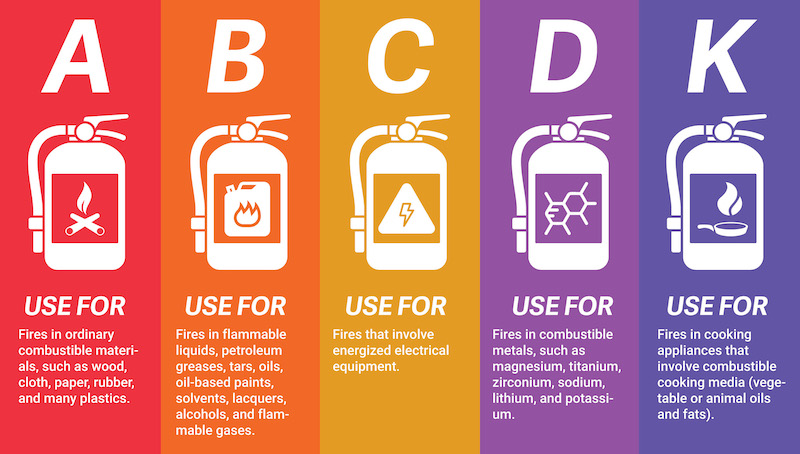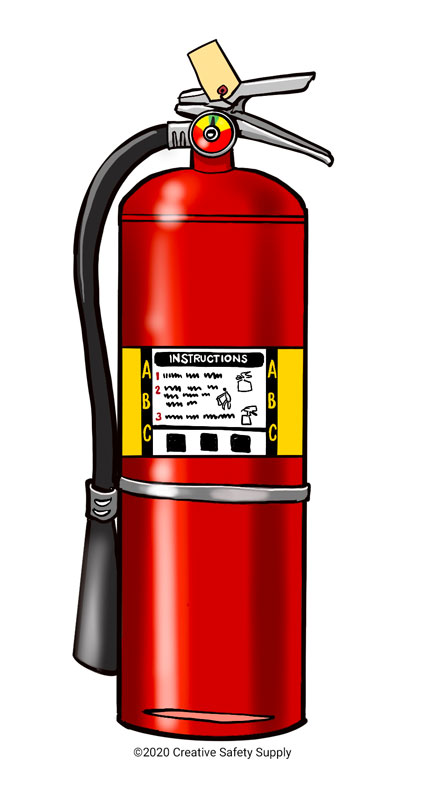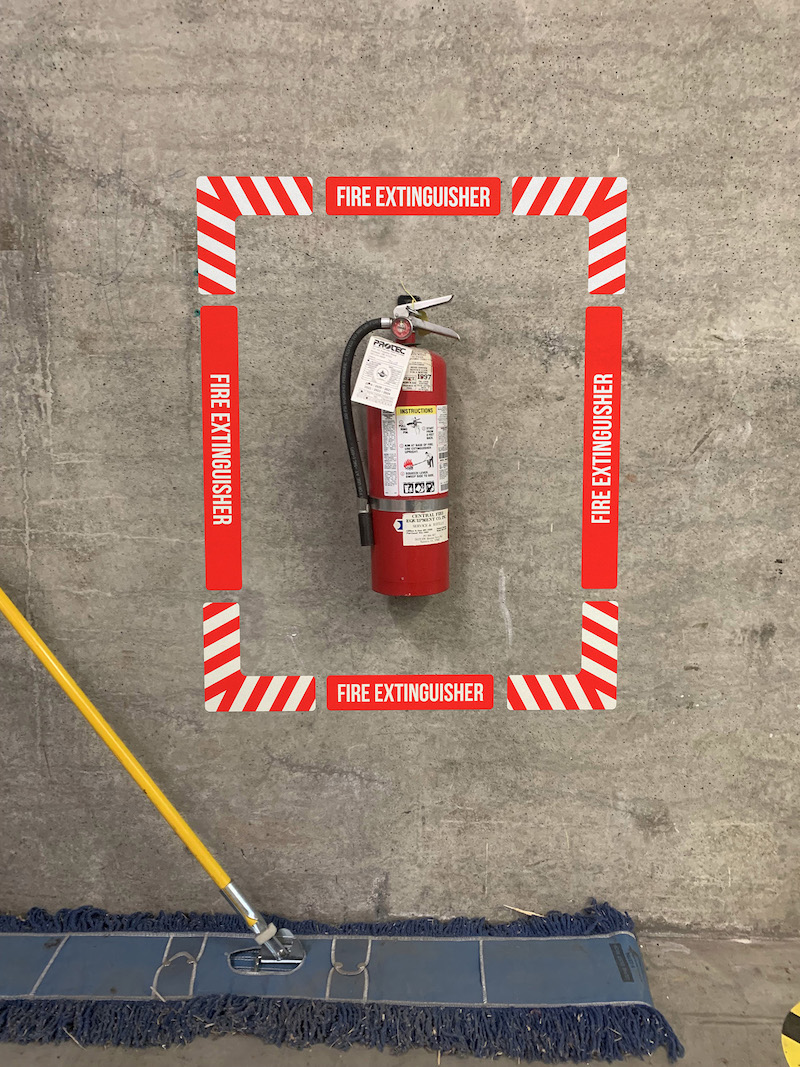

Which Fire Extinguisher Is Used For Electrical Fires?
CO2 fire extinguishers or “Type C” labeled fire extinguishers are most effective in extinguishing electrical fires. These extinguishers displace the oxygen in the air with non-conductive agents like carbon dioxide to prevent the spread of electrical fire. It is important to know the different types of fires or classes of fire extinguishers when dealing with any kind of fire.
Different Types Of Fires
To understand what kind of fire extinguishers are to be used to effectively douse the fire, you need to know the materials involved in the fire to prevent it from spreading. The different types of fires can be divided into six fire classes:
Class A Fires: ordinary materials such as paper, wood, plastics, or textiles can be reduced with common water extinguishers.
Class B Fires: caused by flammable liquids such as petrol, oil, or diesel are ineffective against foam-type extinguishers.
Class C Fires: involve flammable gases like methane, propane, and butane. CO2 fire extinguishers are best suited for these types of electrical fires.
Class D Fires: are a result of burning reactive metals like aluminum, lithium, or magnesium that can be suffocated using foam-type extinguishers.
Class F Fires: to completely extinguish fires involving cooking oil or deep fat, you need a K Class-type fire extinguisher.
It’s important to know the kind of fire you are dealing with to select the right fire extinguisher best suited for them. Knowing the various types of fire extinguishers, lead to preventing the spread of fire and causing long-term damage.
Types of Fire Extinguishers
To effectively deal with a fire, it’s important to note that you have the right type of extinguisher to prevent it from spreading. Using the wrong kind of extinguisher on the wrong type of fire can worsen matters and further contribute to the spread of fire. Note the different types of fire extinguishers listed below:
- Class A Fire extinguishers: Are used for ordinary fires involving wood or plastics. The most common kind of fire extinguishers are water extinguishers best suited for class A fires.
- Class B Fire extinguishers: These are used for flammable liquids and gases, foam extinguishers are optimal for putting out fires due to gasoline, oil, paint, lacquer, and tar.
- Class C Fire extinguishers: To put out electrical fires, CO2 fire extinguishers are the best choice to suffocate the fire by displacing the oxygen to prevent it from spreading.
- Class D Fire Extinguishers: For reactive metal fires due to highly volatile chemicals, class D fire extinguishers are used in research or pharmaceutical labs.
- Class K Fire extinguishers: For kitchen fires due to deep fat or cooking oil, fire extinguishers involving a wet chemical agent are best suited for such fires.
Fire extinguishers are classified according to the types of fires they can put out. There are five main classes of fire extinguishers: A, B, C, D, and K. Each class corresponds to a different kind of fuel that feeds the fire. For example, class A fire extinguishers are designed for ordinary combustible materials such as wood, paper, or cloth; class B fire extinguishers are for flammable liquids such as gasoline, oil, or paint; class D fire extinguishers are for combustible metals such as magnesium, titanium, or sodium; and class K fire extinguishers are for cooking oils and fats.
Class C fire extinguishers are the ones that are used for electrical fires. These fire extinguishers contain non-conductive agents that do not conduct electricity and can safely extinguish fires involving energized electrical equipment. The most common types of class C fire extinguishers are carbon dioxide (CO2) and dry chemical. CO2 fire extinguishers work by displacing oxygen and smothering the fire. Dry chemical fire extinguishers work by interrupting the chemical reaction of the fire and creating a barrier between the fuel and the oxygen.
Best Fire Extinguishers For Electrical Fires
The ideal fire extinguisher for electrical fires is a “Class C Type” fire extinguisher designed to put out electrical fires by suffocating the fire with carbon dioxide at full pressure. This minimizes the fire’s ability to fully react with the oxygen in the air, therefore minimizing its spread to other areas.
A survey conducted in 2017 reported that nearly 4in 10 construction workers were a victim of using the wrong type of fire extinguisher to deal with electrical fires. The risk of electrical fires has increased in recent years due to the increase in use and dependence on modern electrical supplies. With so many electrical hazards at risk, it’s important to know what fire extinguisher to use for an electrical fire.
The best fire extinguisher for electrical fires is a CO2 fire extinguisher. The CO2 in the fire extinguisher replaces the oxygen in the air with carbon dioxide, therefore preventing it from spreading any further. Understanding what type of extinguisher is used on electrical fires is an essential part of electrical safety. Class C extinguishers are commonly found in computer server rooms, workplaces with a big electrical system, and construction sites for this very reason.
What Extinguisher Is Used For Lithium-Ion Battery Fires?
The popular demand and use of lithium-ion batteries is a common modern problem. These rechargeable batteries are found in our mobile phones and other portable devices along with in electric vehicles, e-scooters, and much more. However, these rechargeable batteries are prone to self-heating due to mechanical damage or overuse. Electrical fires from lithium-ion batteries cannot be extinguished using foam or powder-based extinguishers. While “Class C” type water-based extinguishers can be effective by minimizing the fire, they cannot fully put it out as the battery will re-ignite until the cell completely discharges its energy.
Fire extinguishers containing Aqueous Vermiculite Dispersion are best for lithium-ion battery fires. When sprayed, the vermiculite particles are chemically suspended in water which provides a cooling effect and forms a thermal barrier around the burning battery cell to prevent further spread of the lithium fire. This eliminates the risk of the lithium-ion fire from spreading any further.
Tips On How To Use A Fire Extinguisher

To use a class C fire extinguisher for an electrical fire, follow these steps:
- Before attempting to fight the fire, make sure that the power source is turned off or disconnected if possible. This will reduce the risk of electrocution and reignition.
- Check the label and the pressure gauge of the fire extinguisher to make sure that it is suitable for class C fires and that it is fully charged.
- Stand at a safe distance from the fire, usually about 6 to 10 feet away.
- Pull the pin at the top of the fire extinguisher to break the seal.
- Aim the nozzle or hose at the base of the fire, where the fuel source is.
- Squeeze the lever or trigger to release the extinguishing agent.
- Sweep the nozzle or hose from side to side until the fire is out.
- Watch for any signs of re-ignition and repeat if necessary.
Some fire extinguishers are multipurpose and can be used for more than one class of fire. For example, some dry chemical fire extinguishers are labeled as ABC, meaning that they can be used for class A, B, and C fires. However, not all fire extinguishers are compatible with all types of fires. For example, water or foam fire extinguishers should never be used for electrical fires, as they can conduct electricity and cause shock or electrocution. Therefore, it is important to read the label carefully and choose the right fire extinguisher for the situation.
Want to know how many extinguishers your facility needs?
Our free fire extinguisher calculator will help determine the recommended minimum number of portable fire extinguishers for your premises.

Fire extinguishers are essential tools for preventing and controlling small fires in emergencies. However, they are not intended for large or out-of-control fires that require professional intervention. If you encounter an electrical fire that is beyond your ability or capacity to handle, do not hesitate to call 911 or your local emergency number and evacuate the area immediately. Remember that your safety is always the priority.
Additional Fire Extinguisher facts:
- A carbon dioxide fire extinguisher is the right option for dealing with electrical fires. These fire extinguishers are typically associated with the color black, whether this is a panel on the side of the extinguisher or the color of the entire bottle. Source: https://www.britanniaalarms.co.uk/news/which-fire-extinguisher-is-used-for-electrical-fires
- To use a class C fire extinguisher for an electrical fire, follow these steps: 1) Before attempting to fight the fire, make sure that the power source is turned off or disconnected if possible. 2) Check the label and the pressure gauge of the fire extinguisher to make sure that it is suitable for class C fires and that it is fully charged. 3) Stand at a safe distance from the fire, usually about 6 to 10 feet away. 4) Pull the pin and aim the nozzle at the base of the fire. 5) Squeeze the lever and sweep the nozzle from side to side until the fire is out or the extinguisher is empty. 6) If the fire is not out, back away and call for help. Source: https://www.ifsecglobal.com/fire-extinguishers/choose-right-type-fire-extinguisher/
- There are five different fire extinguisher types in the UK, each suitable for different fire classes. They are: water, water mist or water spray, foam, dry powder, carbon dioxide, and wet chemical. The body of the extinguisher is colored red, and a small colored band indicates the type of fire extinguisher. Source: https://www.ifsecglobal.com/fire-extinguishers/choose-right-type-fire-extinguisher/
- Fire extinguishers should be inspected regularly to ensure that they are in good working order and ready to use in case of an emergency. The inspection should include checking the pressure gauge, the nozzle, the hose, the pin, the tamper seal, the label, and the body of the extinguisher. Any signs of damage, corrosion, leakage, or missing parts should be reported and the extinguisher should be replaced or serviced. Source: https://www.yahoo.com/lifestyle/fire-extinguisher-233356405.html
Similar Questions
- How many fire extinguishers should a workplace have?
- What are fire risks in a factory?
- What is a fire prevention system?
- What is fire protection?
- What fire safety equipment should I have in my facility?
- What are fire risks in an office?
- What are some examples of fire protection measures?
- What should be included in fire safety training?
- What is a fire risk assessment?

